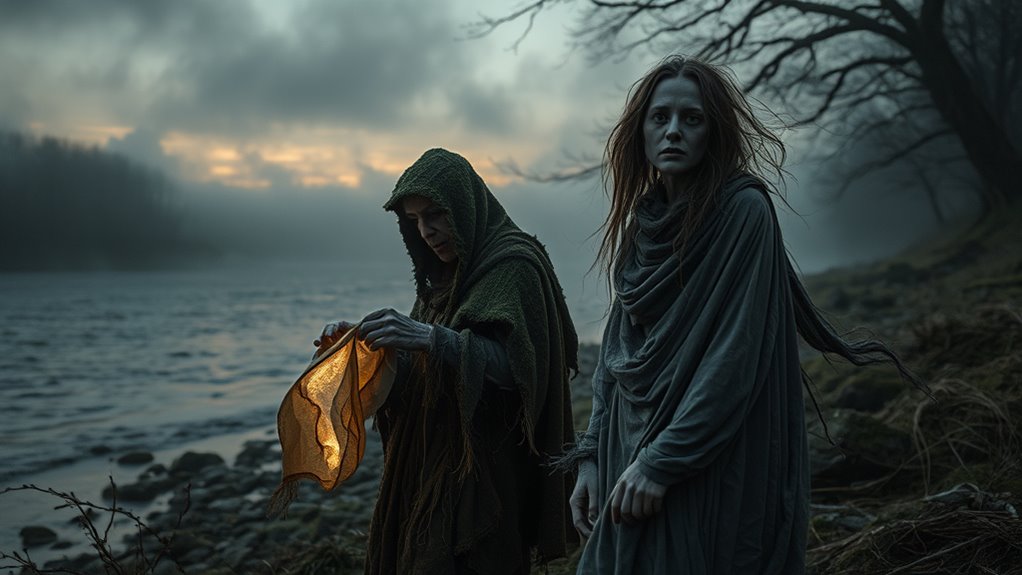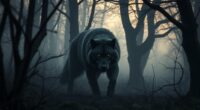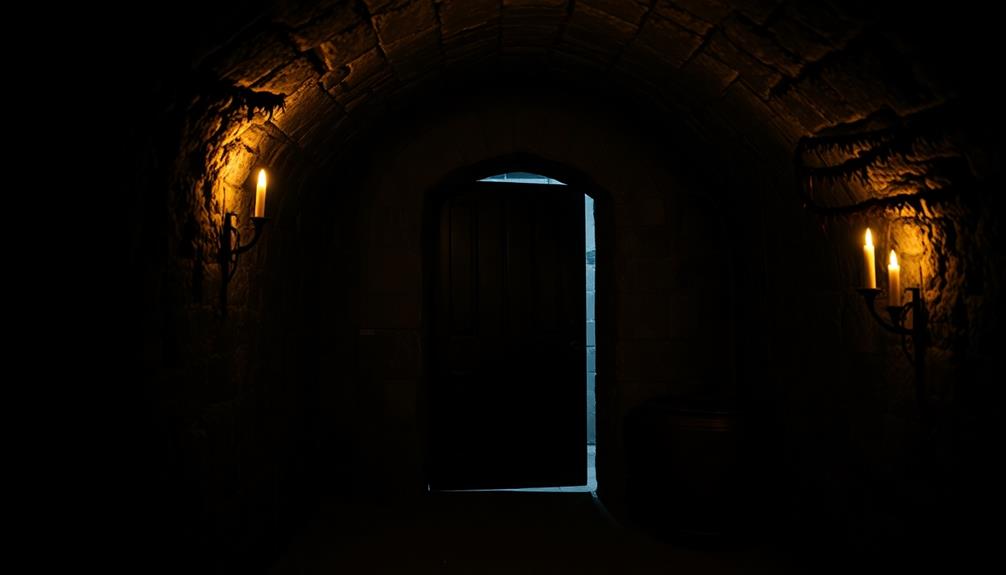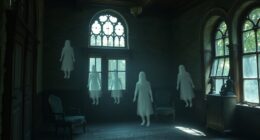If you’re exploring banshee variations, you’ll find that in Scottish folklore, the Bean Nighe is a washerwoman spirit seen near streams, signaling death and fate. In Welsh legend, Gwrach Y Rhibyn appears as a mournful hag whose wails echo grief and tragedy, especially on stormy nights. Both figures embody regional symbols of mourning and mortality, each with unique cultural meanings. Keep going to uncover how these supernatural beings reflect their communities’ beliefs and traditions.
Key Takeaways
- The Scottish Bean Nighe is a washerwoman spirit associated with death, often seen near streams washing bloodstained clothes as an omen.
- The Welsh Gwrach Y Rhibyn appears as a mournful hag whose wails symbolize grief and impending tragedy, especially during stormy nights.
- Both figures serve as cultural symbols of death and mourning, reflecting regional beliefs and societal values.
- While sharing themes of fate and tragedy, Bean Nighe emphasizes destiny through water settings, whereas Gwrach Y Rhibyn embodies mourning through her mournful cries.
- These regional variations enrich the overarching legend of the banshee, highlighting differences rooted in Irish, Scottish, and Welsh folklore.

Have you ever wondered how the haunting sounds of a banshee can vary from one story to another? “Banshee Variations” explores the different ways this legendary creature’s wails are portrayed across cultures and media. While many are familiar with the Irish and Scottish banshee, lesser-known regional folklore** introduces you to intriguing counterparts like the Scottish Bean Nighe and the Welsh Gwrach Y Rhibyn. These figures share similarities with the banshee but also carry unique cultural symbolism** that reflects their origins.
In Scottish folklore, the Bean Nighe, often seen as a washerwoman, is a spirit linked to death and destiny. You might encounter her washing bloodstained clothes in remote streams or near burial sites. Her presence signals impending tragedy, but her role goes beyond mere omens. She embodies the region’s deep-seated beliefs about fate and the supernatural, acting as a harbinger that underscores life’s fragile nature. This cultural symbolism reveals how regional folklore embeds moral and existential lessons into ghostly figures, making them more than just warnings—they’re reflections of societal values and fears. Additionally, the association of the Bean Nighe with water environments highlights the importance of beach and coastal zones in regional folklore, emphasizing their significance as liminal spaces where the supernatural and natural worlds intersect.
Similarly, in Welsh tradition, the Gwrach Y Rhibyn appears as a hag-like creature, often depicted with a threatening or mournful demeanor. You might hear her wails echoing through the valleys, especially during stormy nights. Unlike the Irish banshee’s piercing scream, her cries are often described as a mournful wailing, embodying grief and loss. The Welsh myth encapsulates regional themes of mourning and the supernatural’s omnipresence in everyday life. Her appearance and sounds symbolize the community’s collective memory of tragedy, emphasizing how folklore serves as a means to cope with death and tragedy. The Gwrach Y Rhibyn’s role demonstrates how regional folklore can personify grief itself, turning it into a tangible, almost tangible force.
Across these cultural expressions, you notice common threads: they’re all cautionary figures rooted in regional folklore. The Bean Nighe and Gwrach Y Rhibyn may differ in appearance and the specifics of their wails, but they share a purpose—to serve as ominous signs or symbols rooted in local traditions. Their stories highlight how cultural symbolism shapes supernatural tales, giving them unique flavor while reinforcing universal themes of death, fate, and mourning. These variations enrich the tapestry of the banshee’s legend, illustrating how regional folklore adapts and interprets the supernatural according to local beliefs and fears. By understanding these differences, you gain a richer appreciation for how folklore reflects the cultural fabric of each community, making each creature’s wail a distinct echo of regional identity.
Frequently Asked Questions
Are There Any Modern Sightings of These Spirits?
Yes, you can find modern folklore recounting supernatural encounters with these spirits. People still report seeing the Scottish Bean Nighe washing bloodstained clothes or the Welsh Gwrach Y Rhibyn wailing near old cemeteries. While such sightings are rare and often skeptically viewed, they persist in storytelling and local legends, keeping these supernatural spirits alive in contemporary culture. These tales continue to fascinate those interested in paranormal phenomena.
How Do These Entities Differ From Other Regional Spirits?
You’ll notice these spirits differ from other regional folklore because they embody specific mythological symbolism tied to death and fate. Unlike generic ghosts, the Scottish Bean Nighe and Welsh Gwrach Y Rhibyn serve as omens or messengers, often linked to mortality. Their distinct appearances and roles highlight their cultural significance, making them unique within their regional spirits, deeply rooted in tradition and symbolic meaning that sets them apart from other mythic entities.
Can These Legends Be Traced to Specific Historical Events?
You can trace the historical origins of the Bean Nighe and Gwrach Y Rhibyn to specific events, but much of their folkloric evolution blends myth with history. These legends likely stem from ancient beliefs surrounding death and the supernatural, evolving over centuries through storytelling. While some stories may be linked to historical fears or societal changes, their primary significance lies in their cultural symbolism rather than precise historical incidents.
Are There Any Specific Rituals to Ward off These Spirits?
Imagine a dark, whispering wind carrying warnings—you’re unlikely to find specific rituals to ward off these spirits. Instead, people use protective charms and ritual practices like crossing oneself, carrying amulets, or reciting prayers. These acts create a barrier, a flickering shield against the eerie presence. You can try these rituals, trusting that they might turn the tide, shielding you from the haunting whispers that seek to reach you.
How Have These Stories Influenced Local Cultures and Festivals?
You’ll find that these stories deeply influence local cultures and festivals, shaping cultural celebrations and folkloric traditions. Communities incorporate tales of spirits like the Bean Nighe and Gwrach Y Rhibyn into storytelling events, parades, and rituals to honor heritage and ward off evil. These legends serve as cultural touchstones, strengthening communal identity while offering entertainment and moral lessons rooted in folklore.
Conclusion
Now that you’ve explored the haunting world of banshees, it’s clear these spirits are more than just eerie whispers—they’re the soul’s ultimate warning system. The Scottish bean nighe and Welsh gwrach y rhibyn show just how deeply these legends run through their cultures, echoing like an unstoppable storm of fate. Remember, encountering one of these specters is like staring into the very heart of eternity—an experience that’ll stay with you long after the shadows fade away.










